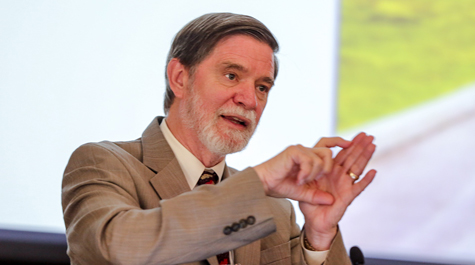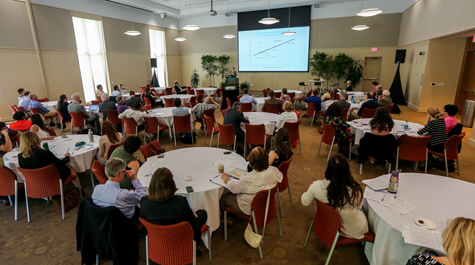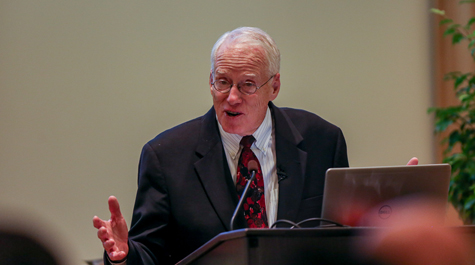Conference on social mobility draws national experts on education, policy and economics
In the age of smartphones, air travel and ride sharing, Americans are more mobile than ever — except, perhaps, in the one way that matters most.
According to Robert Archibald, William & Mary chancellor professor of economics, and David Feldman, professor of economics at W&M, when it comes to measures of social mobility — a concept referring to the generational movement in social status and income over time — the U.S. seems to be falling short.
“People in the U.S. are fond of thinking about the American Dream — that no matter where you come from, if you’re talented and hardworking, you can make it to the top,” said Archibald. “The American Dream is alive and well in lots of other countries, but not so much in the U.S. Measures of social mobility show that we’re not a leader, which I think is a surprise to a lot of people.”
That issue was top of mind in the W&M School of Education on April 21-22, when educators, economists and policymakers from around the country gathered to share research, ideas and discussion at the Conference on Higher Education and Social Mobility. The brainchild of W&M Provost Michael R. Halleran, the event was co-organized by Archibald and Feldman, co-authors of the books Why Does College Cost so Much? and the forthcoming The Road Ahead for America’s Colleges and Universities.
“The cost of college is a perennial one,” said Halleran. “It annually exceeds the rate of inflation … at the same time, we have the growing issue of economic inequality reflecting years of stagnant wages. So the question becomes what role is higher education going to play in addressing that issue?”
The conference kicked off with a welcome address by W&M President Taylor Reveley, who stressed the importance of a society in which social mobility can be achieved by everyone and offered ways to think about tackling the issue from a university standpoint.
“It seems to me the mission is figuring out how does William & Mary reach really able, really promising kids in downtrodden high schools — kids whose lives would be transformed by a William & Mary campus experience and who would in turn contribute significantly to the breadth and depth of William & Mary,” Reveley said. “And once we reach them, how do we persuade students that college is truly important for them and that it is an option for them even in the most academically rigorous, most selective schools?”
In a series of six sessions, speakers presented a wealth of solutions to these and more challenges, ranging in topic from federal and state policy options to the role community colleges and online education can play in advancing social mobility. Sarah Turner, university professor of economics and education at the University of Virginia, shared research on access, or how much high ability, low-income students really know about college, while Sandy Baum, senior fellow with the Urban Institute, focused on how students can navigate their options in federal financial aid.
“Each of the sessions address different ways of thinking about the patterns we see — where low-income students go to college, how they get in, what their financial constraints are,” said Feldman. “These are all things that affect social mobility.”
In the first session, Archibald discussed two solutions for making public investment in education more progressive and more conducive to social mobility.
“You can move the low-income students to where the resources are, or you can move the resources to where the low-income students are,” Archibald said.
Citing research done in conjunction with Feldman and Peter McHenry, associate professor of economics at W&M, Archibald showed the effects of low social mobility in a sample of high school graduates from 2004. Their study analyzed, among other things, student socioeconomic status and academic potential (measured by GPA and test performance) and compared that to the selectiveness of the college the students attended (if any) and their graduation rates.
The results put a spotlight on educational inequality, with students from the upper end of the socioeconomic pool more likely to attend competitive institutions and more likely to graduate. Lower income students, on the other hand, though often testing equally as high in measures of academic potential, are less likely to attend the same schools.
“There’s a lot of evidence that shows that high ability, low income students don’t attend the best schools they could,” said Archibald. “But, if you can get the low-income students into the really good schools, they’re likely to graduate and do well.”
Whether that’s accomplished through outreach or through swapping merit-based for need-based financial aid (or a combination of several things), conference participants left brimming with ideas to mull over back home in their respective roles.
“What we really hope is that folks gather here to listen to the research and participate in a conversation,” said Halleran. “And then as they go out into their various roles, whether it’s at a foundation or in the policy realm, that they’ll carry this knowledge back with them to make positive changes toward ensuring that higher education is a part of American social mobility.”


















